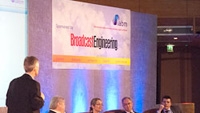IABM annual conference shows optimism

Vendors’ trade association, the IABM (International Association of Broadcast Manufacturers), held its annual conference last week in Windsor, UK. Bylined “Adjusting to new business models, profiting from the journey,” speakers explored trading in an uncertain economic position. Although the audience was predominately European, there was some representation from North American manufacturers.
The opening keynote from the EBU Director of Technology & Development, Lieven Vermaele, explored the future direction of broadcast in the context of the proliferation of new consumer devices — tablets and smartphones. Vermaele posed the question that faces many of Europe’s public service broadcasters (over the air): Can they still afford to chase market trends like 3-D and 4K, or should that be left to subscription channels?
Throughout the conference, there was much talk of the cloud and file-based production. Vermaele’s views on the private cloud were that is another name for integrated, file-based production. He explained that he would like to see the production environment eventually being as simple to operate as a smartphone, and that it would use a generic optimized SOA platform.
“I see IBC in ten year’s time being an app store,” Vermaele said in his closing remark.
There was much discussion about the future role of broadcasters as IPTV, mobile and OTT blur boundaries. Adrian Scott, of Media Asset Capital, felt that “broadcasters reflect the world to a mass audience, anything that is live.”
A panel session on “sizing the business” looked at the potential areas for growth. From the IABM survey at IBC2011 there was strong interest from broadcasters in multiplatform delivery, but spending was on HD migration. It is easy to overlook that much of the world’s broadcasting is still SD, with some broadcasters still analog. This can only present an opportunity to equipment providers. Screen Digest analyst Tom Morrod has seen that while multiplatform doesn’t bring in much revenue, it is seen as an added value for platform providers to remain competitive.
Much of the talk at the conference was the relationship between equipment vendors and broadcasters. Darren Long, Operations Director at Sky Sports, stated “we are in the business to entertain, and to allow viewers to participate. Broadcasters are looking for value for money.”
Sky has just been though a long project to update its infrastructure.
Get the TV Tech Newsletter
The professional video industry's #1 source for news, trends and product and tech information. Sign up below.
“We wanted it cheaper, faster and low power,” the company said. The new building has been planned to be a low energy user, and innovative in many respects.
A thought-provoking presentation from Danny Wilson, founder of Pixelmetrix, contrasted the mobile sector to broadcast (“Their spending on R&D alone is more than the revenue of the broadcast sector,” he said), and how mobile LTE (long-term evolution) and fiber will see an explosion in the bandwidth available to mobile operators; well capable of replacing conventional broadcast with all IP, integrated data, voice and video.
David Peto, CEO of Aframe, a collaborative video platform, described how the cloud is real, here and being used in anger for television production. One of Peto’s stats was that the A/V sector creates 62 Exabytes of data per year, although Steve Plunkett of Red Bee Media pointed out that at his facility they had 500,000 tape movements in 2010.
Strath Goodship, President and CEO of Miranda, closed the conference. He reinforced the importance of live shows to television, and how live underpins the need for SDI infrastructure, with IT/file-based systems for the on-demand content. “Manufacturers need to deliver demonstrable value not be funding experimentation,” he said.
He noted that HD is still the biggest driver for equipment purchases.
With the Euro crisis hovering, some of the audience were uncertain of the future. But, Goodship listed some thoughts to be optimistic about, including the fact that TV still takes 65 percent of global advertising revenue, and that the 2012 US elections will see record levels of advertising spend — a big help to the local stations in the U.S. market.
He sees multiscreen as a big opportunity, and emerging markets being one-third of equipment spend by 2015. Brazil, Russia, India and China, along with the Middle East, are all increasing television infrastructure, and Africa is starting to emerge as a player.
Talking about multiscreen, Goodship recalled one US broadcaster that creates 370 versions of a program.
"The complexity is growing faster than revenues,” he said.
The challenge to the broadcast manufacturing sector, as Vermaele said at the start of the conference, is to simplify the operation of the complex systems. Outsourcing to cloud service providers, and the move to a SOA are two vaunted solutions.
